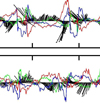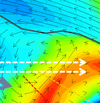
2014 THEMIS SCIENCE NUGGETS
SUMMARIES OF THEMIS RESEARCH
| <<View 2013 THEMIS Nuggets | Return to main page |
 Huishan Fu, October 2014
Huishan Fu, October 2014First observation of rising-tone magnetosonic waves
As the THEMIS spacecraft travel from the Earth’s plasmasphere to the outer radiation belt they observed a previously unknown plasma wave. This wave- partly sound and partly electromagnetic- is structured into sequences of rising tones either as they are being created or due to their propagation from the source region to the satellite, and remain an active area of study because of their potential in affecting space weather. Read more.
 Guanqing Yan, August 2014
Guanqing Yan, August 2014Are Kelvin-Helmholtz vortices present under southward Interplanetary Magnetic Field?
Recently, THEMIS observations said “Yes” with clear evidence and regularity, detecting the induced electric field caused by the magnetic field compression at the edges of the vortices. Read more.
 Quanqi Shi and Michael Hartinger, May 2014
Quanqi Shi and Michael Hartinger, May 2014THEMIS observed magnetospheric vortices driven by solar wind pressure pulse
We report the first in-situ observation of a plasma vortex induced by a solar wind dynamic pressure enhancement using THEMIS satellites inside our terrestrial magnetosphere - the region of Geospace shielded from the solar wind - and this finding is further confirmed by numerical simulation and ground-based observations. Read more.
 D. Megan Gillies, March 2014
D. Megan Gillies, March 2014A Survey of Quiet Auroral Arc Orientation and the Effects of the Interplanetary Magnetic Field
Where auroral arcs form, how they are oriented with respect to Earth’s magnetic field, and how often they occur as a single arc or as part of a multiple arc system all yield important clues on how Earth’s magnetosphere works and how it relates to the bigger Sun-Earth system. Read more.
 Mark Engebretson, February 2014
Mark Engebretson, February 2014Investigating the IMF Cone Angle Control of Pc3-4 Pulsations Observed on the Ground
A study of Pc3-4 magnetic pulsations reveals the limitations of current monitoring spacecraft in the solar wind upstream of Earth's magnetosphere for accurately characterizing the interplanetary magnetic field that interacts with Earth's space environment. Read more.
 Brian M. Walsh, February 2014
Brian M. Walsh, February 2014Simultaneous Ground and Space-Based Observations of the Plasmaspheric Plume and Reconnection
THEMIS and GPS TEC observations reveal how processes inside the magnetosphere provide critical feedback to lower the efficiency of solar wind energy transfer. Read more.
 Justin H. Lee, February 2014
Justin H. Lee, February 2014On the presence and properties of cold ions near Earth's equatorial magnetosphere
THEMIS measurements reveal MLT-dependent properties of equatorial cold ion species. Read more.
 Nan Jia, January 2014
Nan Jia, January 2014Discrete Auroral Arcs Generated by Ionospheric Feedback Instability
New 3D computer simulations can accurately reproduce auroral structures by varying ionospheric electric field and plasma density parameters.Read more.
 Jiang Liu, January 2014
Jiang Liu, January 2014Magnetic flux transport by dipolarizing flux bundles
Statistical study shows that dipolarizing flux bundles are the major and highly efficient magnetic flux transporter of the near-earth magnetotail. Their flux transport properties shape the near-earth tail convection. Read more.
 Please send comments/suggestions to
Emmanuel Masongsong / emasongsong @ igpp.ucla.edu
Please send comments/suggestions to
Emmanuel Masongsong / emasongsong @ igpp.ucla.edu